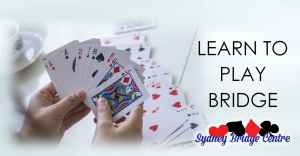City and Canada Bay – Monday Morning 28th October 2024.

A very common theme when declaring a hand in a trump suit is the need to set up a side suit (usually by ruffing losers in it to make the rest of the suit good). Board 8 last week was a good example of this for North South.
The auction will start 1♦ P 1♥. South may now have some choices. He could overcall 1♠ but he may also be able to show a hand with at least 55 in the other two suits – similar to how a Michaels cue bid does over an opening bid. Exactly when he might do that and which bid he uses to do so is subject to partnership agreement (see advanced section for more) but most commonly it would be 2♥ – ie the same as over a 1♥ opening on his right.
If South bids 1♠, West is likely to rebid 2♣ (which may also deny 3 hearts – see advanced section). North should now make a cue raise (perhaps with 2♦) to show a good spade raise. But East knows his side has a large diamond fit and with his shape he may well just jump straight to 5♦. That definitely makes it hard for North South and if South doesn’t bid 5♠ then North will probably double 5♦ which should collect 300.
If South instead bids Michaels,showing 55+ in the black suits this will change the auction. West may well now pass. North now has a huge hand and will agree spades strongly. East probably bids 5♦ as before but this time North South are more likely to push onto 5♠. One of the more reliable “rules” of bridge is NOT to bid “5 over 5” but on this hand (with the Michaels auction) it’s more reasonable for North South to do so. See advanced section for why.
What about the play? In diamonds East West have 4 pretty clear losers (2 spades and 2 red aces). That means 5♦ is a good sacrifice over 4♠ (assuming doubled its -300 instead of -420 or -450). But North South can make 5♠. The key to doing so is to get their side club suit going. The defence will most likely lead their diamond suit which declarer wins with ♦A (discarding his heart loser). Now the key play is to NOT draw trumps yet but to immediately start playing on clubs. Putting the ♣K up is probably wrong as West (with the opening bid) is far more likely to have ♣A. So declarer should just duck a club. The defence will likely play another diamond forcing South to ruff. Then he should duck another club. If West had ♣Ax initially that makes the rest of the clubs winners already; if West had ♣Axx the 3rd round can be ruffed high to also set the suit up; and even here, where West has 4 clubs it’s still ok.
After the 2nd club is ducked a 3rd diamond will force South to ruff a 2nd time. But that’s OK – after ruffing a club high (if necessary) declarer only NOW starts to draw trumps by crossing to hand in trumps to ruff his next club (also high – note how valuable it is to have all the top trumps). That 2nd club ruff finally sets the suit up and he can cross back to hand to draw any remaining trumps. That makes 11 tricks just losing the two clubs.
Several declarers didn’t make 11 tricks in spades though. I suspect they didn’t start on clubs early enough. If they drew trumps first then they will be in trouble when forced to ruff diamonds later. They needed the trumps as entries back to their own hand to ruff the clubs.
Some declarers might also have tried a cross ruff. But that can’t work to make 5♠ – count the tricks (this was also mentioned in last weeks column). To make 11 tricks, declarer has 2 red aces so would need to score all 9 of his trumps separately. But is that possible? No because he would need to score the ♠5 in the North hand with a ruff and that will get overruffed. So the most tricks declarer can get that way is 10. That counting should point him to the fact that clubs must be set up. As so often is the case when a side suit needs to be set up it’s right to get going on it as soon as possible – rather than automatically drawing trumps first.
Key points to note
Many hands played in a trump suit require a side suit to be set up. If it requires losers being ruffed in the other hand it’s nearly always right to start doing this straight away – i.e. before drawing trumps.
It’s worth discussing your bids after 1m P 1M. What is 1NT? What do 2m and 2M mean? Michaels? Natural?
With a lot of shape and a known big fit with partner, don’t be afraid to jump he bidding high quickly. That puts a lot of pressure on the opponents.
Bidding 5 over 5 is nearly always wrong! The only times it tends to be right is if you have extreme extra shape.
More advanced
In auctions like 1m P 1M regular pairs should discuss what their bids mean. It’s quite useful to still be able to show a Michaels type hand (55+ shape) but some pairs like to limit this to showing either a weak hand or a strong hand but not an intermediate one (this makes it easier for partner to judge what to do). Hence an intermediate hand would overcall one suit and hope to be able to show the other later.
1NT by a non-passed hand here is best played as natural (15-18) but by a passed hand can be played as something else (eg 55 in the unbid suits).
Another treatment that’s becoming increasingly common to play at least one of the bids of the opponents’ suit as natural (after all 1♦ or 1♥ in this auction could easily be bid on xxxx). Otherwise, to show the suit naturally you have to pass and then bid it on the next round (which can be awkward if the opponents have pushed the bidding much higher by then). Imagine if South had a strong heart suit here and passed over East’s 1♥. He may well find the auction at the 5♦ level by the time he gets another bid! It would have been much more comfortable for the auction (1♦) P (1♥) 2♥ to have shown hearts. As usual there’s no perfect answer – whatever you play will suit some hands better than others. You just need to both be on the same wavelength!
I also said over South’s 1♠ a 2♣ rebid from West may deny 3 hearts. That would be the case if the pair are playing support doubles. It’s a popular method nowadays. Double of any bid from South up to 2♥ would show 3 hearts and is normally West’s first priority. Therefore, when he DOESN’T double but instead passes or bids something else then there’s a negative inference available that he denies 3 hearts. (Be conscious that the opponents are entitled to this information as well so East should alert West’s pass or bid). Note how useful that negative inference might be to East when he holds 5 hearts as he now knows there isn’t a fit.
When faced with a bridge decision at the 5 level it is uncanny how often it is WRONG to bid 5 over 5. A common saying is “the 5 level belongs to the opponents”. On this hand, however, it is actually slightly better for North South to bid 5♠ as they can make it for +450 instead of +300 from 5♦x.
There are two hints here:-
a) South has extra shape over and above what he’s already shown. If he’s bid Michaels he has already shown 55+ but here he is 65 and also has a void (6511 would be far less powerful). He also has little defence to diamonds.
b) Once North learns South is at least 55 shape, he knows his two red aces are enormous. They are known to be opposite a hand which has at most 3 red suit cards. Hence North knows there can be at most 1 red suit loser.
Here though if anyone is going to bid 5♠ over 5♦ it’s South. But even that isn’t clear. I have lost count of the number of times I have thought similar conditions applied and bid on, only to discover that even with a very shapely hand I have still converted a plus score to a minus score! Moral of the story is – be VERY wary of bidding 5 over 5. You usually need significant extra shape.
Julian Foster (many times NSW representative) ♣♦♥♠



